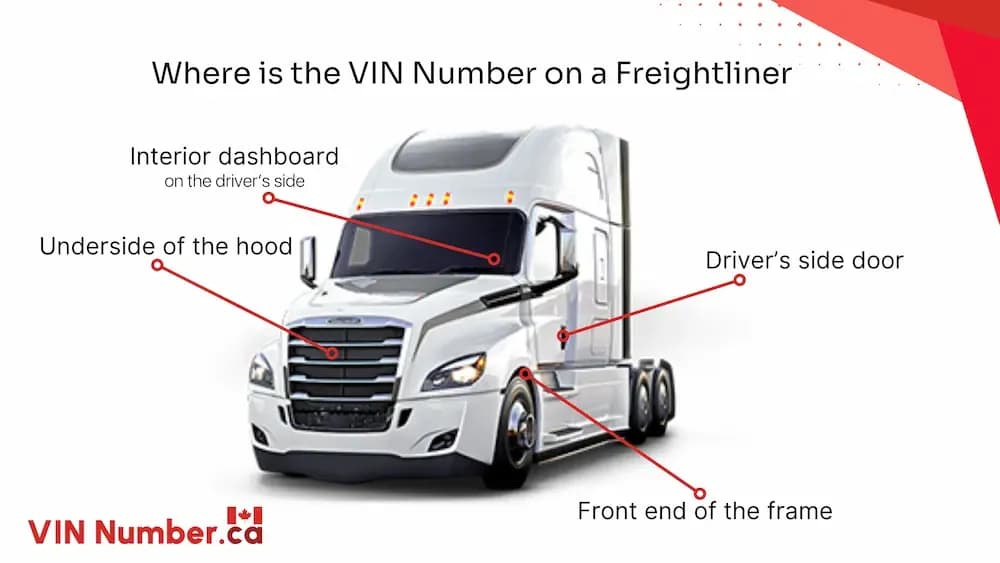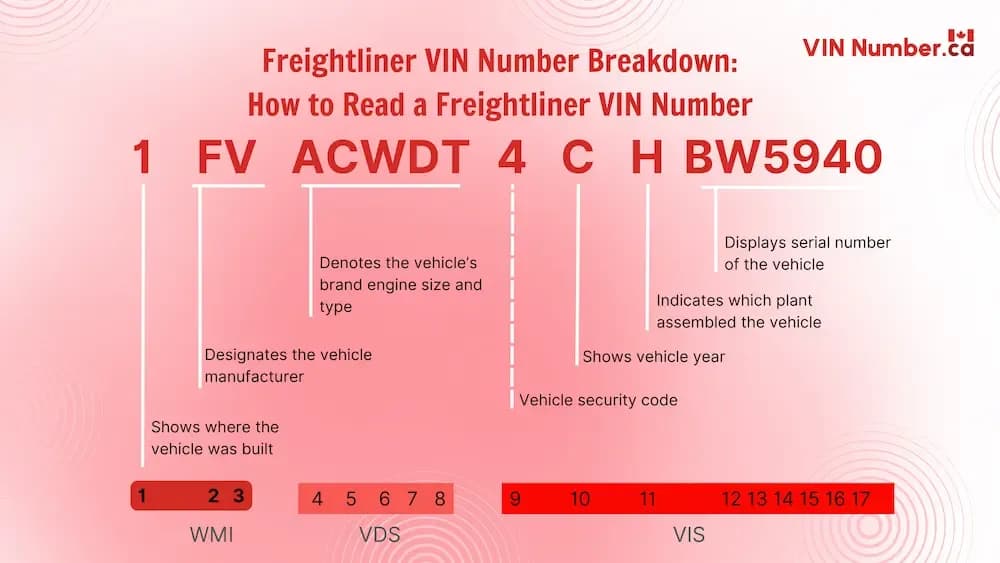Freightliner VIN Decoder
Looking at a second-hand Freightliner? Decode the Freightliner’s VIN to protect yourself from scams and make sure the truck’s history is clean and reliable. View specifications, history records, and more.
What is a Freightliner VIN Decoder?
A Freightliner VIN decoder is a tool used to decode Freightliner’s VIN to view vehicle specifications and history records. The VIN consists of 17-digit numbers and letters used to identify a vehicle.
When you decode the VIN, you will get detailed information about the vehicle, such as accident records, mileage, theft records, and more.
Why You Have to Decode the Freightliner VIN?
Buying a used truck without doing proper background checking is risky; you don’t want to end up buying a truck with a lot of hidden problems.
Here’s why you need to do proper truck background checks with the Freightliner VIN decoder tool:
Check the original features
See what the vehicle came with from the factory to make sure it still has its original parts and options.
Look into accident history
Find out if the vehicle was ever involved in a reported crash, which helps you spot possible problems like structural damage.
See past ownership details
Learn how many people owned the car before and how long they kept it. This can give you an idea of how well it was maintained.
Watch for mileage issues
Check if the odometer reading makes sense or if there were signs of tampering that could affect the vehicle’s value.
Find active recalls
Look up any open safety recalls that may need fixing to make sure the car is safe to drive.
Review sales and auction history
Get a glimpse of previous sales or auctions, including where and when they happened, sometimes with photos to show how the car looked back then.
What Does a Freightliner History Report Show?
No need to worry about background checks. Our Freightliner VIN decoder service has two different options you can choose from: a free and a paid VIN decoder.
Opted for the free VIN decoder? Sure, you will get the basic information of the vehicle, you can use to examine the vehicle’s specifications and features, and see if they match to seller’s description.
The free VIN decoder gives you some basic but useful info to help you see if the car details match what the seller told you..
Here’s what you will find with the free VIN decoder:
- Year
- Make
- Model
- Trim
- Engine specs and size
- Transmission type
- Drive type
- Body type
- Fuel type
- Tire pressure info
- Emissions rating
- Braking system
Prefer the paid VIN decoder? That’s even better. With our paid VIN decoder, you will get more information about the truck, aside from the basic specifications. See what you will get with our paid VIN decoder.
- Vehicle specifications
- Ownership history
- Title brands (salvage, rebuilt, etc.)
- Accident and damage history
- Lien and loan records
- Warranty information
- Service and maintenance records
- Vehicle usage (personal, taxi, rental, etc.)
- Auction records and photos
- Sales history
- Recall information
- Mileage records
Examine These Spots to Find Freightliner’s VIN
You can find the VIN on a Freightliner by yourself. Pay attention to these spots to locate the VIN easily.
- Front of the engine block
- Dashboard of the vehicle
- Driver’s side door jamb
- Vehicle documents
- Vehicle emission sticker

How Can I Decode a Freightliner VIN?
Do you know that you can decode the Freightliner’s VIN by yourself? You just need to get the VIN and follow these steps to decode the VIN easily:
Step 1: Find the VIN
First thing, you will need to find the VIN you want to decode. If you have a classic Freightliner VIN, you can decode it here, too.
Step 2: Click on the Form
Fill out the form with the VIN along with your email address and phone number to begin the VIN decoding process.
Step 3: Get the Report
Receive your vehicle history report in under a minute. Don’t forget to download it and review the key details before making a purchase.

Why Do You Need to Decode Freightliner VIN?
Tom wanted to buy a used vehicle for a road trip. The vehicle was in very good condition, according to the private seller, who is based in the Montreal area. Fortunately, Tom was curious enough to run a VIN check to get the full information about the vehicle’s past.
What’s in the report?
- Damage Records (2)
- Salvage branded title
- Events reported (1)
- Auction/Sales (1)
Outcome:
Tom confronted the private seller, who told him that the vehicle is clear of any accident by bringing a copy of the vehicle history report. Tom cancelled the purchase because the vehicle had been marked as salvaged.
See Freightliner Original Specs by Window Sticker
A Freightliner window sticker offers more than basic specs. You’ll be informed on the truck’s features, interior and exterior colors, fuel economy, safety scores, warranty coverage, and more. You’ll also find the original MSRP, factory-installed options, and any extra packages added before it hit the road.
How to Manually Decode the Freightliner’s VIN?
The Vehicle Identification Number is an identifier used to identify a certain vehicle, even though the year, make, and model of the vehicle are the same. It consists of a 17-digit mixture of numbers and letters.
The VIN is divided into three sections:
- WMI (World Manufacturer Identifier): The first three characters indicate the country of origin and the manufacturer of the vehicle.
- VDS (Vehicle Descriptor Section): Characters 4 to 9 describe important details like the vehicle’s model, body type, engine, and other major specs.
- VIS (Vehicle Identifier Section): The last eight characters (10 to 17) reveal the model year, the factory where it was built, and its unique serial number.

Deciphering the VIN:
- 1st Character: Shows in which country the vehicle was manufactured. If the first digit starts with the numbers 1,2,3,4,5, the vehicle was manufactured in North America, like the US or Canada.
- 2nd Character: This digit helps identify the specific manufacturer or division, even if the Freightliner is made in different regions or plants.
- 3rd Character: Indicates the type of vehicle, whether it's a truck, semi-truck, or another class of commercial vehicle.
- 4th Character: Refers to the body type and drivetrain setup, such as day cab, sleeper cab, or 2WD vs. 4WD.
- 5th Character: Tells you what kind of engine the vehicle has: diesel, natural gas, or a specific cylinder configuration.
- 6th Character: Represents the vehicle’s series or line. This may vary across models, so using a Freightliner VIN decoder can help clarify.
- 7th Character: Indicates the safety features included by the manufacturer, like the number of airbags or other safety systems.
- 8th Character: Identifies the trim level or configuration, for example, whether it's a basic work truck, premium model, or equipped with extra options.
- 9th Character: This is the check digit, which confirms the VIN’s authenticity by using a mathematical formula.
- 10th Character: Reveals the model year of the Freightliner. Letters and numbers are used to represent different years.
- 11th Character: Shows which manufacturing plant built the truck.
- 12th to 17th Characters: These final digits form the vehicle’s unique serial number, setting it apart from every other Freightliner, even ones built at the same factory.
Freightliner Facts You Need to Know
- Leading Manufacturer of Heavy-Duty Trucks: Freightliner is one of North America's top producers of Class 8 trucks (the heaviest category), widely used for long-haul transport, logistics, and construction. Their flagship models include the Freightliner Cascadia, known for its fuel efficiency and comfort.
- Owned by Daimler Truck North America: Freightliner is a subsidiary of Daimler Truck AG, a global commercial vehicle giant. This connection allows Freightliner to benefit from advanced German engineering, safety tech, and innovation.
- Pioneer in Electric Trucks: Freightliner is among the first major manufacturers to release electric commercial trucks, such as the eCascadia and eM2. These zero-emission models are part of Freightliner's push toward sustainable, eco-friendly transport solutions.